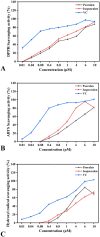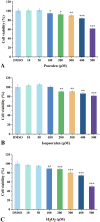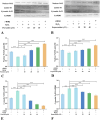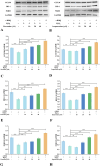Psoralen and Isopsoralen Activate Nuclear Factor Erythroid 2-Related Factor 2 Through Interaction With Kelch-Like ECH-Associated Protein 1
- PMID: 39867839
- PMCID: PMC11761412
- DOI: 10.1002/fsn3.4768
Psoralen and Isopsoralen Activate Nuclear Factor Erythroid 2-Related Factor 2 Through Interaction With Kelch-Like ECH-Associated Protein 1
Abstract
As natural furocoumarins, psoralen and its isomer isopsoralen are widely distributed in various fruits including Ficus carica L., vegetables including celery, and medicinal herbs including Psoralea corylifolia L. Although psoralen and isopsoralen have been used as dietary supplements because of their bioactivities such as antibacterial and anti-inflammatory properties; however, the potential mechanisms underlying the antioxidant activities of these two furocoumarins still need to be explored. Hence, the aims of this work were to examine the activation of nuclear factor erythroid 2-related factor 2 (Nrf2) by psoralen and isopsoralen, as well as the binding interaction of Kelch-like ECH-associated protein 1 (Keap1) with these two furocoumarins. Interestingly, both psoralen and isopsoralen induced Nrf2 nuclear translocation in a dose-dependent manner in HEK293T cells. These two furanocoumarins also activated antioxidant response element (ARE)-driven luciferase activity. The mRNA expression of GCLM, HO-1, and NQO1 genes was significantly upregulated by treatment of HEK293T cells with psoralen and isopsoralen, respectively. Similarly, the expression of proteins can be promoted. Both psoralen and isopsoralen were located in the top of the central pocket of the Keap1 Kelch domain, suggesting that they were natural ligands of Keap1. In conclusion, both psoralen and isopsoralen activate Nrf2 through interaction with Keap1, thereby serving as natural antioxidants.
Keywords: Nrf2; antioxidant response element; isopsoralen; molecular docking; psoralen.
© 2025 The Author(s). Food Science & Nutrition published by Wiley Periodicals LLC.
Conflict of interest statement
The authors declare no conflicts of interest.
Figures








Similar articles
-
Isolation and purification of psoralen and isopsoralen and their efficacy and safety in the treatment of osteosarcoma in nude rats.Afr Health Sci. 2014 Sep;14(3):641-7. doi: 10.4314/ahs.v14i3.20. Afr Health Sci. 2014. PMID: 25352883 Free PMC article.
-
Studies on the metabolites difference of psoralen/isopsoralen in human and six mammalian liver microsomes in vitro by UHPLC-MS/MS.J Pharm Biomed Anal. 2017 Jul 15;141:200-209. doi: 10.1016/j.jpba.2017.04.026. Epub 2017 Apr 20. J Pharm Biomed Anal. 2017. PMID: 28448889
-
Psoralen and isopsoralen from Psoraleae Fructus aroused hepatotoxicity via induction of aryl hydrocarbon receptor-mediated CYP1A2 expression.J Ethnopharmacol. 2022 Oct 28;297:115577. doi: 10.1016/j.jep.2022.115577. Epub 2022 Jul 22. J Ethnopharmacol. 2022. PMID: 35872289
-
Nuclear factor (erythroid-derived 2)-like 2 (NRF2) drug discovery: Biochemical toolbox to develop NRF2 activators by reversible binding of Kelch-like ECH-associated protein 1 (KEAP1).Arch Biochem Biophys. 2017 Oct 1;631:31-41. doi: 10.1016/j.abb.2017.08.003. Epub 2017 Aug 8. Arch Biochem Biophys. 2017. PMID: 28801166 Review.
-
Age-related cataracts: Role of unfolded protein response, Ca2+ mobilization, epigenetic DNA modifications, and loss of Nrf2/Keap1 dependent cytoprotection.Prog Retin Eye Res. 2017 Sep;60:1-19. doi: 10.1016/j.preteyeres.2017.08.003. Epub 2017 Aug 31. Prog Retin Eye Res. 2017. PMID: 28864287 Free PMC article. Review.
Cited by
-
Integrative metabolomics and system pharmacology reveal the antioxidant blueprint of Psoralea corylifolia.Sci Rep. 2025 Aug 5;15(1):28632. doi: 10.1038/s41598-025-14469-z. Sci Rep. 2025. PMID: 40764661 Free PMC article.
References
-
- Ai, G. , Wu X., Dou Y., et al. 2022. “Oxyberberine, a Novel HO‐1 Agonist, Effectively Ameliorates Oxidative Stress and Inflammatory Response in LPS/D‐GalN Induced Acute Liver Injury Mice via Coactivating Erythrocyte Metabolism and Nrf2 Signaling Pathway.” Food and Chemical Toxicology 166: 113215. - PubMed
-
- Bajpai, V. K. , Alam M. B., Ju M. K., et al. 2018. “Antioxidant Mechanism of Polyphenol‐Rich Nymphaea nouchali Leaf Extract Protecting DNA Damage and Attenuating Oxidative Stress‐Induced Cell Death via Nrf2‐Mediated Heme‐Oxygenase‐1 Induction Coupled With ERK/p38 Signaling Pathway.” Biomedicine & Pharmacotherapy 103: 1397–1407. - PubMed
-
- Ding, X. , Zhao H., and Chen Q.. 2022. “Icariin Protects Podocytes From NLRP3 Activation by Sesn2‐Induced Mitophagy Through the Keap1‐Nrf2/HO‐1 Axis in Diabetic Nephropathy.” Phytomedicine 99: 154005. - PubMed
-
- Eggler, A. L. , Gay K. A., and Mesecar A. D.. 2010. “Molecular Mechanisms of Natural Products in Chemoprevention: Induction of Cytoprotective Enzymes by Nrf2.” Molecular Nutrition & Food Research 52: S84–S94. - PubMed
LinkOut - more resources
Full Text Sources
Research Materials
Miscellaneous

